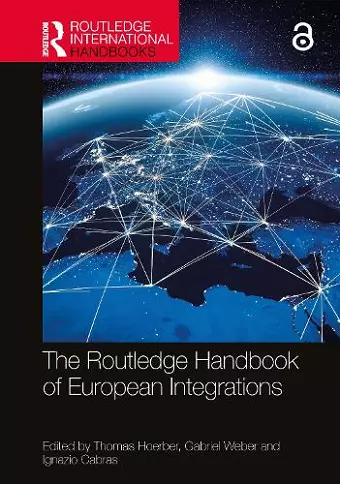The Routledge Handbook of European Integrations
Ignazio Cabras editor Thomas Hoerber editor Gabriel Weber editor
Format:Paperback
Publisher:Taylor & Francis Ltd
Published:27th May '24
Currently unavailable, and unfortunately no date known when it will be back
This paperback is available in another edition too:
- Hardback£215.00(9780367203078)

The Routledge Handbook of European Integrations fills a significant gap in the European studies literature by providing crucial and groundbreaking coverage of several key areas that are usually neglected or excluded in European integration collections. Whilst still examining the largest and most influential institutions, bodies and highly-funded policy areas as acknowledged dominant topics in European studies, it crucially does so with much greater balance by devoting equal billing to areas such as culture in European integration or new technologies and their impact on the EU.
Organised around three main sections – culture, technology and ‘tangibles’ – the book:
- offers an authoritative ‘encyclopaedia’ to ‘alternative’ areas in European integration, from media, football, Erasmus and tourism, to transport, space, AI and energy;
- retains coverage of the dominant topics in European studies, such as the Eurozone, the Common Internal Market, or European law, but in balance with other areas of interest; and
- provides an essential companion to existing scholarship in European studies.
The Routledge Handbook of European Integrations is essential reading and an authoritative reference for scholars, students, researchers and practitioners involved in, and actively concerned about, research in the study of European integration/studies.
The Open Access version of Chapter 14 in this book, available at http://www.taylorfrancis.com, has been made available under a Creative Commons Attribution-Non Commercial-No Derivatives 4.0 license.
"Routledge Handbooks have proved to be invaluable resources for lecturers, students and researchers, and an excellent way to engage the general public in the respective fields. This highly significant and long overdue addition to the series perfectly showcases the diverse character of European integration and very well complements the EU-centric mainstream literature. It is a key reference for exploring the rich panoply of cross-border activities incorporated in the wider process of European unification."
Martin Dangerfield, University of Wolverhampton, UK
"This volume is a timely and refreshing take on the many different ways in which Europe (including but not only the EU) has sought to, failed to or managed to integrate. Far from limiting themselves to the usual suspects (referred to in the volume as the ‘tangibles’) such as the single market, the authors tackle a breadth of subjects including AI, space and cyber. The line-up of contributors is as diverse as the subject coverage is novel, making this a must-read for those seeking out new ways of thinking about the likely futures of Europe."
Helen Drake, Loughborough University, UK
"Inspired by Jean Monnet’s ideas and responding to the editors’ question of whether we are ready for a United States of Europe, the contributors to this volume have provided an excellent up-to-date analysis about the degree of European integration achieved in fields that have been overlooked without at the same time neglecting to highlight the achievements and failures in the more traditional fields of integration. Focusing on the cultural and technology sectors, the book shows ways of European integration which were not expected and indicates areas of concrete progress of European integration where no one would have dared to touch on national prerogatives in Monnet’s time. The editors have done an outstanding job in putting together a very comprehensive volume that would be of great value to scholars and analysts as well as to graduate and undergraduate students interested in European integration."
Yannis Stivachtis, Jean Monnet Chair, Virginia Tech, USA
ISBN: 9781032182421
Dimensions: unknown
Weight: 453g
488 pages